
8D ASSOCIATION
The 8D Association is dedicated to promoting the history of the railways of South Lancashire, Merseyside and North Cheshire.
The Willis Branch – a journey from Huyton Quarry to Cronton Colliery in 1969.
Foreword by – Frank Green.
This history of the Willis Branch was kindly donated to me by Mr Bill Blinkhorn as some source material which he suggested might be of use in my search for information while I was in the process of compiling my own local and railway history project.
The essay compiled in 1969 by Mr J C James, who was a member of the Huyton-with-Roby Historical Society is now the best part of fifty years old. It gives not only an authoritative history since the line was first laid down, in the early 1830’s, but a comprehensive description of the Branch as it was seen at that moment in time. However, with the passing of another near half century, J C James’ work has in fact, become history itself, as the sights and landmarks he has recorded have been swept away in the huge changes made in the last few decades of the twentieth century.
I believe this to be an invaluable record, and certainly it should be regarded of huge local interest. As such, I decided to re-type Mr James’ essay and thus preserve at least one refreshed copy. This copy has been passed to the 8D Association and an abridged version is reproduced here. Frank Green July 2013.
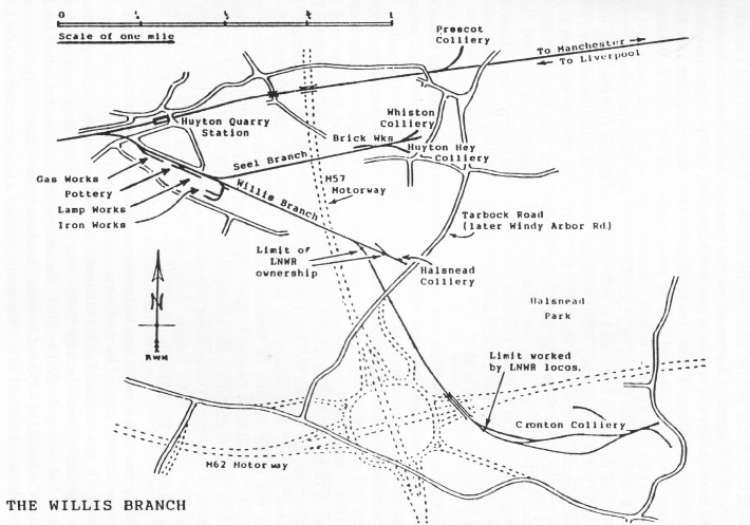
The Journey.
The enthusiast who arrived at Huyton Quarry station in its heyday, might be forgiven for thinking that its name was a misnomer. Once having ascended from the platform to the roadside via the footbridge, he would no doubt pause to peruse the contents of the windows of an adjoining row of shops, before returning to the station and making his way along Hall Lane, to the level crossing situated a little way uphill from St Gabriel’s Church. The view across the station is a real panorama of industrial archaeology. Collieries, brickworks, electric lamp works, gas works, blue works, iron works potteries and stone quarries were all to be found within the middle ground of this vista of some mile or so in length. The present day affords one a combined view of links with the past and modern development. To the extreme left can be seen St Nicholas’ Church, Whiston, with the former Wigan and Whiston Coal Company’s colliery chimney, (now in use by Messrs Tushingham’s Metallic Brick Company) in the middle ground. In the centre of the panorama can be seen running diagonally, in a N.W. – S.E. direction, the Willis Branch, from the point where it leaves the main line, due West of Huyton Quarry station, and heads across the countryside to join the Halsnead Branch, just below the rows of miner’s cottages, aptly named Cronton Avenue and Halsnead Avenue, before going through a sandstone cutting under Windy Arbour Road and entering the former estate of R A Willis called Halsnead Par, a modern plastics factory, the old and new links across the Mersey with nearby Frodsham and Helsby, and further over, a view across the Wirral peninsular, also the Childwall Valley embracing Woolton and its church.

Thus the scene is set for our trip, in both past and present, so to speak, along the Willis Branch. The whole site of Huyton Quarry station is that of Huyton Quarry, filled in so as to enable the main line to be laid and progress up the inclined plane once situated at Whiston and latterly used by locomotive power, which was housed in an engine shed just beyond the Eat end of the Down platform, where the outward-bound colliery trains shunted in order to gain access to the Willis Branch crossover. On arrival at the Hall Lane level crossing entry to the line is gained via a gate, closed out of working hours but now open, which keeps vehicular traffic from entering either the branch line or the railway sidings. On an adjacent island platform, with its former transhipment hut – now demoted to a store – we find the train crew ready and in possession of the train staff for the journey down to the colliery at Cronton. The usual make up of an empty train is some fifty open wagons, two brake vans and the locomotive, perhaps a Class 8F 2-8-0, a Class 5 4-6-0, or (of earlier years) an LNWR G2 0-8-0. Speed is restricted to somewhere in the region of ten miles per hour and with frequent changes in gradient on such a short run, it will be an all-out effort! Possession of the train staff is essential, plus the fact that the lines at Cronton Colliery are free from traffic, and able to receive the train of empty wagons, in return for a loaded train.
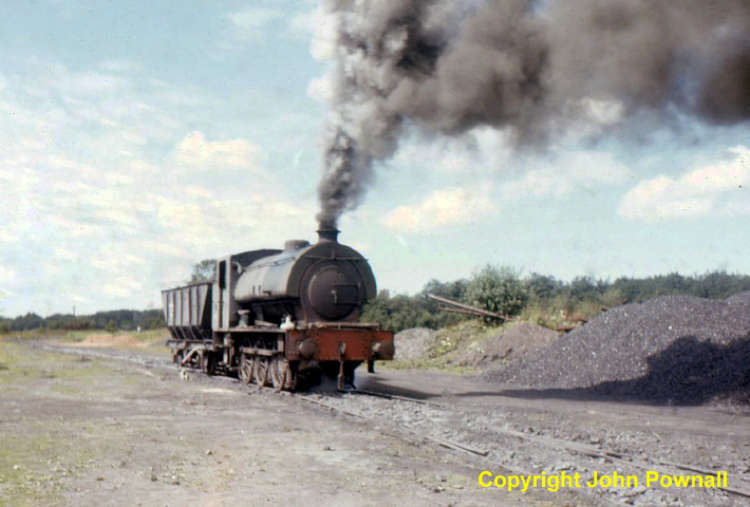
As we move off past the notice-board reminding drivers that they must be in possession of the train staff prior to departure along the branch, we pass the only gradient post now remaining (vandals have removed the rest). This is aptly marked 1 in 685/1 in 136, and while we are protected with a red flag as we cross over Hall Lane, we leave the Down gradient of 1 in 685 and head up a short 1 in 136 before coming to the longest Down gradient on the outward trip.This 1 in 84 commences a little way beyond the bricked up gateway (right),formerly the gateway by which the Abram Coal Company and other merchants delivered and received goods relevant to the production of coal gas at the Huyton Quarry Gas Works. Apart from a slight bend here, the line runs in a straight route up to its junction with the Halsnead Branch. We continue along past the gas works site, bounded on the left by the stone wall which joined us immediately we left the level-crossing, and on the right by the wall which bounds both the gas works site and that of Scraton’s Pottery, presently occupied by British Preserves Limited. Still at a Down gradient of 1 in 84,we pass the site of the B.I.C.C Limited Premises siding (right), which also led into their works behind the boundary wall and fence forming the continuation of the gas works wall.
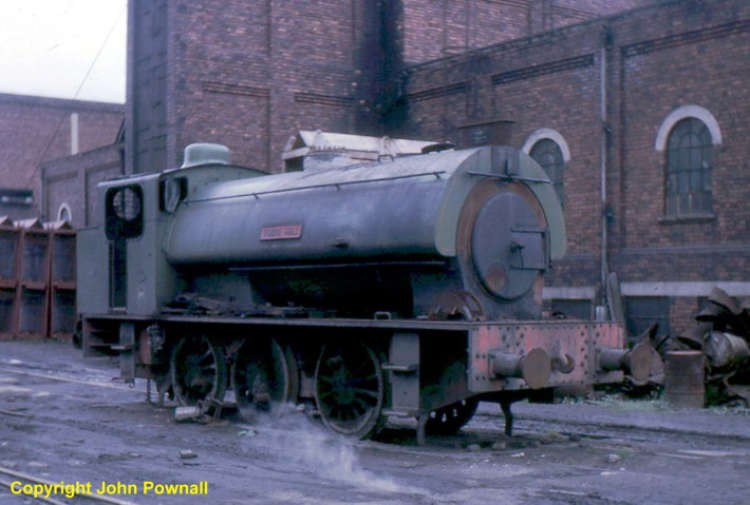
Almost immediately beyond, we cross a now-closed level-crossing that once conveyed traffic from Hale View Road, (left). Which runs parallel to the line from Hall Lane, to Ellis Aston Street, between the B.I.C.C. premises and the former iron works office, (right). On our left is the site of the Seel Branch, and a panorama of the same concerns as before, but from another angle is opened up. Formerly as one left the Seel Branch, in order to enter the Willis Branch with a train, a whitewashed cottage was passed, (latterly known as Branch House Farm) adjacent to it was a water tank, fed from the Liverpool Corporation Works water main, used by Messrs Tushingham’s Metallic Brick Company locomotives, as being better for their boilers that fed from the Whiston area water supply, to the brickworks. This cottage lasted until 1948, when it was demolished, the tank having long since vanished when the Seel Branch was lifted, save for a small section in the brickworks at Whiston, now buried under rubble. This was laid in flat-bottomed rail. The earthworks of the branch are however still to be seen!
Immediately to the right of the site of the Steel-Willis Branch junction is the sole remaining building of the once-mighty Huyton Quarry Iron Works (the Band Room). This was the office which was at one stage used by the Huyton Quarry Temperance Band fir its rehearsals, hence the nickname. At this point from 1916-1926, the ‘Paddy’ commenced its run to Cronton Colliery. Just beyond the office was the siding connection to the Iron Works. It is not known exactly when theses facilities were installed of lifted, but the firm of C&L Shaw Limited was incorporated on January the Twenty Second of 1907 as a private company for the purpose of taking over the Huyton Quarry Iron and Steel Works and continuing the manufacture of iron and steel. Both bar and sheet metal were produced at the works, whose steam hammer could be heard for a considerable distance away.The company was wound up in August of 1909, the premises being taken over by H. Spiro and Company Limited, for use by them as a granite works. The rail facilities were not used however. After this, Messrs Watson, Todd Limited, had a sawmill and timber yard on the site, before the local council took it over as a depot.
Descending still at 1 in 84, the line runs onto a stone embankment as we head out into the open countryside towards the site of the old Halsnead Colliery. Shortly before a occupation crossing on the embankment is reached, the Down gradient changes to 1 in 189, and just beyond it, the train crossed over Logwood Mill Brook, leaving the embankment behind, to travel on the only level stretch, running from the three-quarter mile mark for a furlong, and (right) in so doing, passes an old mine shaft in the undergrowth, which at one time employed female labour who made the descent of the mine by means of a ring fixed above the bucket used for the removal of the coal.
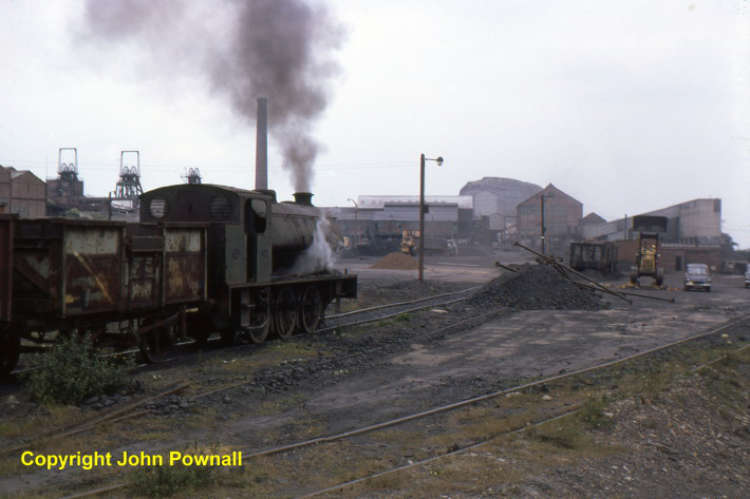
The final approach to the boundary with the Halsnead Branch is made at an ascending gradient of 1 in 75, the line turning in a more southerly direction as it does so, and coming under the shadow of the modern B.I.P. Chemicals Limited fctory, which blocks the once-pleasant view forming one of the amenities of the terraced miners’ houses in Cronton Avenue. At this point it is worthy of note that the branch originally ran straight on into sidings of Mr Willis’ Halsnead Colliery. These were later retained for coal storage purposes by the Hulton Colliery Company, being known as Tarbock Road Yard. But in the pre-1939/1945 Second World War period, they were removed.The installation was protected by trap points (as the sidings were on a Down gradient).
The Halsnead Branch, the gradients of which have not yet been traced, continues from the site of a former white boundary gate, the stumps of whose posts are the sole remains now (but at one time the stump carried a maintenance plate, in addition) and running in a more southerly direction, enter the sandstone cutting below the frontage of Cronton Avenue (which houses were built for the Hulton Colliery Company) and climbs up to the brick built road bridge carrying Windy Arbour Lane (late Tarbock Road) over the track.Further on, the tree-lined cutting give way to an occupation crossing serving (right) Carr House Farm, a very old sandstone edifice best viewed from Windy Arbor Road. Access to which can be gained via the footpath on our left, by which the miners used to walk to the colliery, entering the path from a turnstile (recently disappeared!). A little uphill, but on the opposite side to the turnstile, can be seen the sole-surviving building from Mr Willis’ Colliery. A house, which at one time had a road weigh-bridge close by (road-borne coal traffic used this even when the Tarbock Road Yard was in being). Behind this many years ago, when it is believed the premises were used as offices, lay the derelict vertical boiler from one of the mine’s sets of pithead gear, until scrapped.
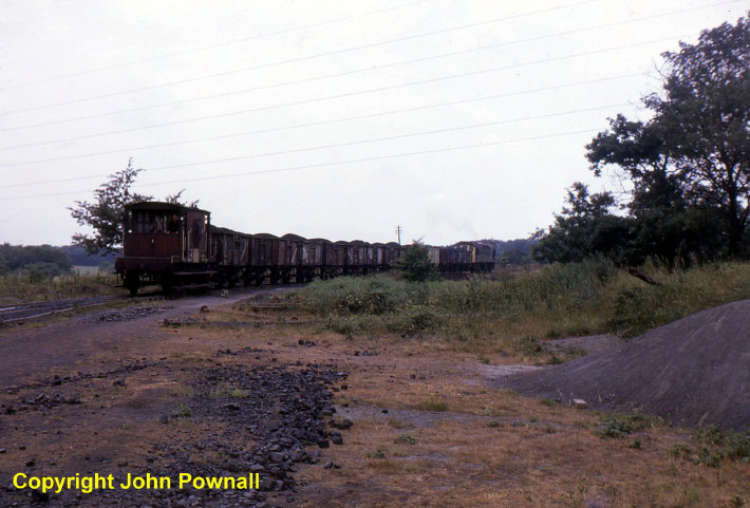
At the occupation crossing is the limit for British Rail locomotives, 1606 yards. To travel further requires permission from the colliery. Just beyond (right) is the disused Leather’s Siding, a lengthy loop going as far as the colliery yard. To the left is a slight dip where a stream flowing through the Old Wood runs under the line, continuing southwards on its course from Big Water, up in Halsnead Park. The line veers due east, and for a time runs straight before passing the site (left) of Sour Hey Pit, since filled in, to provide extra space for storage sidings. To our right Leather’s Siding re-joins us, making way for the points which open out into the network of sidings that comprise the colliery yard. We have now reaches the limit of our journey, a colliery in the middle of a former private park, contrasting surroundings, with some good distant views nevertheless.
J.C. James 1969.
John Pownall has an interesting and ever expanding Flickr photostream, if you wish to see more of his work click here
